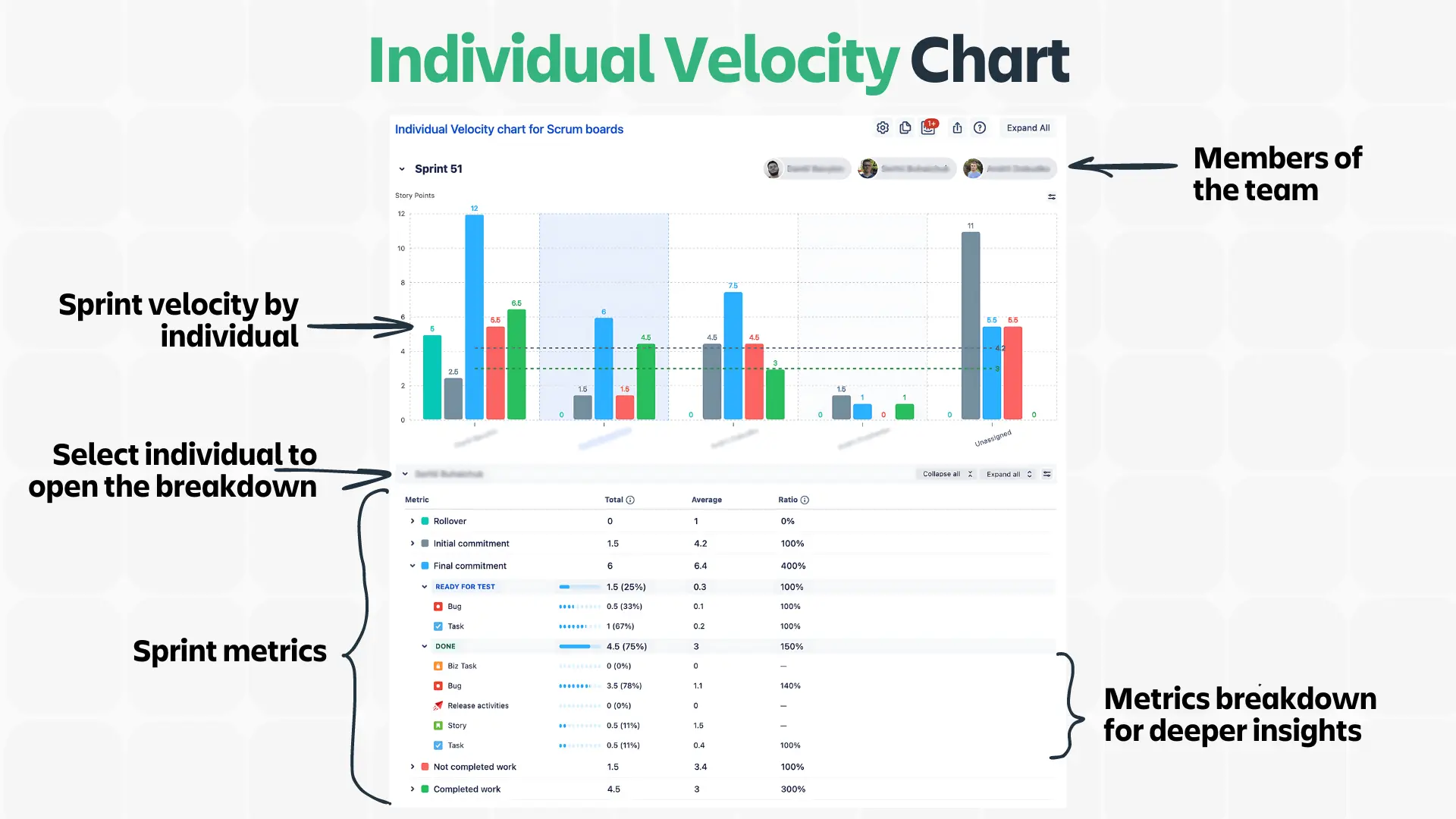In this article

Individual Velocity: pineapple on pizza of the Agile world
Individual velocity in Jira has always been a hot topic. Some see its value, while some think it does more harm than good. Let's break it down and see how to make this metric work for everyone.
What is individual velocity?
Individual velocity measures the amount of work a single team member completes during a sprint. It's typically calculated in story points or hours. While team velocity focuses on the collective output, individual velocity zeroes in on personal contributions. This can help identify productivity patterns, skill gaps, and workload distribution.
So why the hate?
Imagine you're at a party, and someone's constantly watching how many chips you eat. Awkward, right? That's how team members often feel about individual velocity.
Team members often feel like individual velocity puts them under a microscope, which can lead to:
- Unhealthy competition: Suddenly, everyone's trying to be the "velocity champion." It's like a sprint turned marathon and not the good kind.
- Increased stress: Pressure to perform can be overwhelming.
- Gaming the system: Some people might start choosing easier tasks just to pump up their numbers. It's like picking the low-hanging fruit and leaving the tough stuff for others.
This focus can turn a happy team into a bunch of stressed-out individuals faster than you can say "sprint planning."
But here's the plot twist: managers love this metric! To them, individual velocity in Jira is like a crystal ball showing team dynamics and resource needs.
Making individual velocity work for everyone
Alright, now let's turn this villain into a hero. To really leverage individual velocity in Jira, you need to start looking beyond the numbers.

Here’s how:
1. Understand the context: If Sarah's velocity dropped this sprint, don't jump to conclusions. Maybe she's been mentoring the new guy, or perhaps she got stuck with a particularly nasty bug. Context is king!
2. Break it down:
- By Issue Type: Separate bug fixes, stories, and tasks. Imagine Tom's velocity is through the roof, but he's only doing simple tasks. Meanwhile, Jane's velocity is lower, but she's tackling complex features. Who's really adding more value?
- By Priority: If Mike's always firefighting high-priority issues, his velocity might look lower than Lisa's, who's cruising through planned work. High-priority tasks can overwhelm. Knowing this helps with better planning.
- Look even deeper:
The latest update to the Agile Velocity Chart gadget in Jira introduced Custom Assignee fields. This is a game-changer! Now, you can assign tasks more specifically (like “Developer” or “Tester”). This means:
- You’ll see who’s doing what more accurately.
- How different roles contribute (developers, testers, designers, etc.)
Example: Instead of just seeing "Task A - Assigned to Emma," you might now see "Task A - Dev: Emma." This granular view helps you understand individual contributions better.
Advanced sprint metrics for better insights
Want to get more from your individual velocity chart? Check out these advanced metrics:
- Initial & Final Commitment: Track how much work team members take on. This helps identify if they’re overcommitting.
- Rollover: Seeing tasks roll over more often than a dog? Time to dig into why and help the team finish work within the sprint.
- Completed vs. Not Completed Work: Celebrate the wins, but also learn from the misses. If Ana consistently completes her work while Tim struggles, maybe they can pair up and share some knowledge.
Changing the game: mindset matters
Changing how people view individual velocity is like turning a ship - it takes time and effort. Here's your captain's guide:
- Promote Improvement, Not Punishment: Frame velocity discussions like a personal best in sports. "Hey Alex, looks like you increased your velocity this sprint. What worked well for you?"
- Be Transparent: Have open discussions about metrics. It's not a secret sauce; it's a team recipe.
- Focus on Learning: Use retrospectives to grow. "Team, our velocity dipped this sprint. What can we learn from this?"
- Regular Check-Ins: Make one-on-ones as regular as your coffee breaks. Use them to understand individual challenges and wins.
Remember the goal: happy customers
At the end of the day, customer satisfaction is what matters. Use individual velocity to support this goal, not as the only measure of success. It’s just one piece of the puzzle.
Additional tips to leverage the individual velocity tracking
- Customer Feedback: Regularly collect feedback to see how changes in velocity affect satisfaction.
- Quality Over Quantity: Focus on delivering high-quality features that meet customer needs.
How to get velocity chart in Jira dashboard
1. Search for Agile Velocity Chart Gadget in Atlassian Marketplace. Or use this link instead.
2. Start confidently with a free 30-day trial.
3. Navigate to Your Dashboard: Head over to your Jira dashboard, where you can add gadgets.
4. Add the Individual Velocity Chart Gadget: Look for the Individual Velocity Chart by Broken Build in the gadget directory. Add it to your dashboard.
5. Configure the Gadget:
Select the Board: Choose the Scrum board you want to track.
Set the Metrics: You can choose to track story points, issue count, or time estimates.
Filter Options: Apply filters by epics, release versions, or custom JQL functions to tailor the data to your needs.
6. View and Analyze: Once set up, the gadget will display detailed velocity charts. You can switch between team and individual views to get insights into specific contributions and overall team performance.

More examples of using individual velocity in Agile
Need more tips on using this metric for good?
Not a problem, we have 5 real-life examples.
1. Balancing Workloads:
In one tech company, they noticed that one developer, Mark, had a much higher individual velocity than others. This initially seemed great, but upon closer inspection, it was clear Mark was overworked and on the brink of burnout. The team used this insight to redistribute tasks more evenly. They also implemented a buddy system where Mark mentored newer developers, which not only balanced the workload but also enhanced team skills.
2. Identifying Skill Gaps:
At a startup, tracking individual velocity revealed that certain team members struggled with backend tasks while excelling in frontend work. By identifying these skill gaps, the team could provide targeted training and mentorship. They also adjusted task assignments to play to each member's strengths, leading to a more efficient and happier team.
3. Onboarding New Team Members:
A large enterprise used individual velocity tracking to monitor the progress of new hires. They noticed that new team members initially had lower velocities, which was expected. By tracking their progress over several sprints, they could see clear improvements. This data helped set realistic expectations and provided insights into how well the onboarding process was working. It also highlighted areas where new hires needed more support.
4. Improving Estimation Accuracy:
In an Agile consultancy, analyzing individual velocities helped refine their estimation process. They found that some team members consistently underestimated or overestimated certain types of tasks. By understanding these patterns, they could adjust their estimation techniques, leading to more accurate sprint planning and better resource allocation.
5. Optimizing Pair Programming:
A software development team used individual velocity data to create more effective pairs for pair programming. By pairing developers with complementary strengths and weaknesses, they saw improvements in both code quality and overall productivity. For example, a developer with high velocity in writing tests was paired with one who excelled in implementing features, leading to a more balanced and productive workflow.
Hopefully, this has convinced you that individual velocity is not an enemy but can, when used wisely, be the secret sauce in your agile recipe.
FAQ: Questions About Individual Velocity
How often should we check individual velocity metrics?
Review them at the end of each sprint. This keeps things timely without micromanaging.
Can individual velocity be part of performance reviews?
Sure, but don’t rely on it alone. Combine it with other factors like teamwork and quality.
How do we stop team members from gaming the system when tracking individual velocity?
Build a culture of trust. Emphasize that metrics are for improvement, not judgment.
Should we share individual velocity metrics with the whole team?
It depends! If your team trusts each other, sharing can boost transparency. If not, keep it between individuals and managers.
How can we use individual velocity to improve team performance?
Look for patterns and bottlenecks. If someone excels in a certain area, let them share their knowledge!
What if there's a big gap in velocity between team members?
Investigate why. Use regular 1-on-1s, talk to your people. It could be differences in task complexity or experience. Use it as a chance to learn from each other.
How do we integrate individual velocity with other agile practices?
Use it to inform sprint planning and retrospectives. It helps with task allocation and identifying training needs.
Can we focus on individual velocity?
Absolutely! Balance it with other important factors like quality and team collaboration.






.png)






.png)

